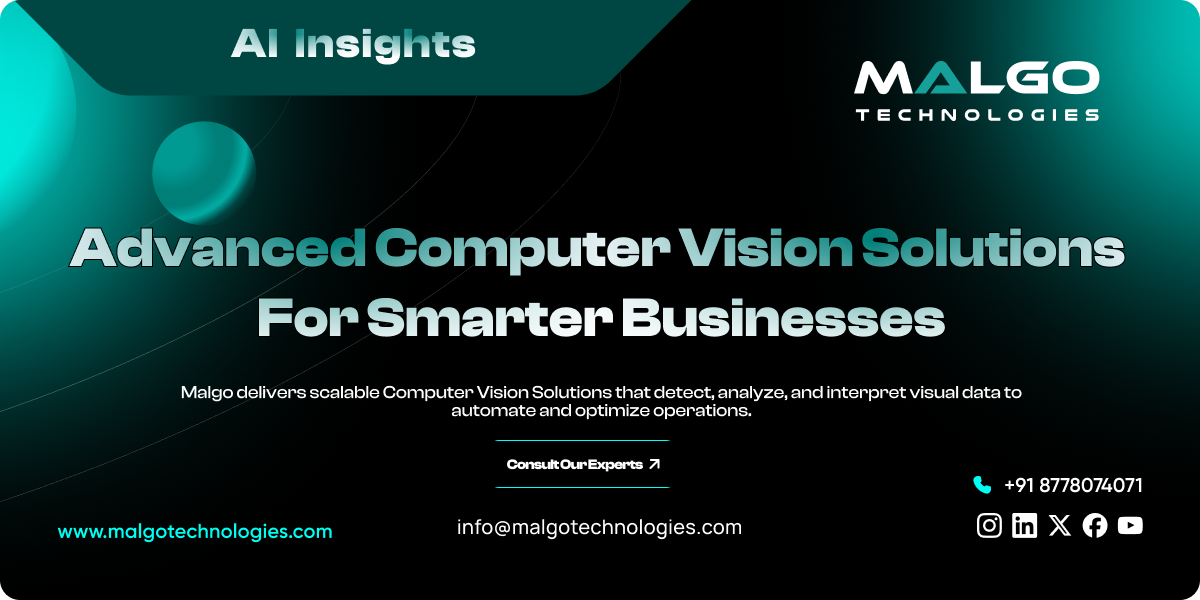Introduction
Computer vision solutions are revolutionizing the way machines perceive and engage with visual environments. The ability of machines to "see" and interpret their surroundings has transitioned from speculative concepts to practical applications. Today, an AI development company plays a critical role in building and deploying advanced computer vision technologies that allow systems to extract meaningful insights from visual data. This progression is not just about recognizing objects; it's about enabling machines to understand context, identify patterns, and make informed decisions—fundamentally transforming how various industries operate.
What is Computer Vision and How Does It Impact Technology Today?
Computer vision is an area of AI that enables computers and systems to analyze and make sense of visual inputs from photos and video content. It replicates aspects of human sight and cognitive abilities, allowing machines to recognize objects, people, and patterns with precision. Today, computer vision influences technology across numerous domains, from aiding medical diagnostics to enabling autonomous vehicles. Its influence is rapidly expanding, driving automation, improving decision-making, and increasing efficiency in diverse applications.
What Exactly Is a Computer Vision Solution and Why Is It Important?
A computer vision solution refers to a system or application that leverages computer vision techniques to solve specific real-world problems. These solutions are important because they automate tasks that traditionally required human visual inspection or interpretation. This includes everything from quality control in manufacturing to security surveillance, allowing for faster processing, consistent accuracy, and the ability to operate in environments where human presence might be impractical or unsafe. By providing machines with the capacity to understand visual data, these solutions enhance operational capabilities and open new avenues for innovation.
How Do Computer Vision Solutions Work to Analyze Images and Videos?
Computer vision solutions work by employing sophisticated algorithms and machine learning models, particularly deep learning and neural networks. The process typically begins with image acquisition, where cameras or sensors capture visual data. This raw data then undergoes preprocessing to address imperfections like poor lighting or blur. Following this, the core of the analysis involves the trained models. These models analyze the visual input, identifying features, classifying objects, and understanding spatial relationships. For instance, a system might analyze a video stream to detect specific movements or examine an image for product defects. The insights derived from this analysis can then trigger actions or inform decisions, much like how a human would react to visual information.
What Are the Key Features That Make Computer Vision Powerful?
The power of computer vision stems from several key features. Its ability to identify and categorize objects within images and video streams is fundamental. Beyond simple recognition, it can segment images into meaningful parts, allowing systems to distinguish between different elements. Pattern recognition enables computer vision to identify recurring visual elements and predict outcomes, vital for fraud detection or monitoring crop health. Motion analysis and tracking allow systems to monitor object movement, crucial for sports analytics or logistics. Advanced techniques like scene reconstruction can even create detailed 3D models from 2D images, with applications ranging from virtual reality to architectural planning. These combined capabilities allow for a comprehensive understanding of visual environments.
What Are the Main Benefits of Using Computer Vision Solutions for Businesses?
Businesses gain significant advantages from implementing computer vision solutions. These benefits include enhanced quality control, as computer vision can detect defects and inconsistencies with accuracy, reducing waste and improving product standards. It facilitates efficient automation across various processes, from automated inspections in manufacturing to inventory management in warehouses. Computer vision enhances safety and security by enabling real-time monitoring and identifying unusual activities. Furthermore, it enables predictive maintenance by identifying early signs of equipment wear, minimizing downtime. The ability to extract actionable insights from vast visual datasets also leads to better decision-making and optimized operations.
What Different Types of Computer Vision Services Are Available?
The field of computer vision encompasses a range of specialized services, each addressing distinct visual analysis needs:
Image Classification: Categorizing an entire image into predefined classes, for example, identifying an image as containing a "cat" or "dog."
Object Detection: The process of recognizing and pinpointing particular objects in an image by outlining them with bounding boxes, such as detecting every car in a city street view.
Semantic Segmentation: Assigning a class label to every pixel in an image, effectively segmenting the image into distinct regions corresponding to different object categories (e.g., separating the sky, road, and cars pixel by pixel).
Instance Segmentation: Similar to semantic segmentation, but it also distinguishes between individual instances of the same object class (e.g., identifying each distinct car in an image, even if they are the same model).
Optical Character Recognition (OCR): Converting various types of images containing text into machine-readable text data, applicable to printed or handwritten documents.
Facial Recognition and Analysis: Identifying and verifying individuals based on their facial features and analyzing facial expressions for emotion or demographic insights.
Image and Video Captioning: Automatically generating textual descriptions or summaries for images and videos, explaining their content.
Image Enhancement and Restoration: Improving the quality of images by removing noise, blurring, or restoring details from degraded visuals.
3D Vision and Depth Estimation: Reconstructing 3D information from 2D images or estimating the distance of objects from the camera.
Pose Estimation: Identifying and tracking the position and orientation of a person or object in an image or video, often used for human activity analysis.
Anomaly Detection: Identifying unusual patterns or outliers in visual data that deviate from expected behavior, crucial for security and quality control.
Industries Can Benefit From Implementing AI-Powered Computer Vision Services?
Almost any industry that generates or interacts with visual information can significantly benefit from implementing AI-powered computer vision services. This includes a wide array of sectors, each leveraging the technology in unique ways to enhance operations, improve decision-making, and create new possibilities.
Healthcare is seeing transformative applications. AI-powered computer vision aids in the precise analysis of medical images, such as X-rays, MRIs, and CT scans, for earlier and more accurate disease detection. It also assists in complex surgical procedures, providing enhanced visual guidance, and contributes to patient monitoring, ensuring well-being and detecting anomalies.
In Manufacturing, AI-powered computer vision is integral for automated quality control, rapidly identifying defects on production lines that might be missed by the human eye. It also supports automated assembly processes and enables predictive maintenance by monitoring equipment for signs of wear and tear, preventing costly breakdowns.
Retail operations are being revolutionized by AI-powered computer vision through intelligent inventory management systems that track stock levels and product placement. It also provides valuable insights into customer behavior, helping optimize store layouts and merchandising strategies, and facilitates seamless, personalized shopping experiences, including self-checkout systems and loss prevention.
The Automotive sector is perhaps one of the most prominent adopters, with AI-powered computer vision forming the core of autonomous vehicles, enabling them to perceive their surroundings, detect obstacles, and navigate safely. It also enhances driver assistance systems and contributes to traffic monitoring for improved urban mobility.
Agriculture utilizes AI-powered computer vision for precision farming. Drones equipped with computer vision technology can monitor crop health, detect pests and diseases early, and assess soil conditions, leading to optimized resource allocation and increased yields. Automated harvesting systems also benefit from visual recognition for picking ripe produce.
For Security and Surveillance, AI-powered computer vision plays a critical role in enhancing public safety and asset protection. It enables intelligent intrusion detection, advanced access control systems, and real-time monitoring of public spaces for suspicious activities.
In Logistics and Supply Chain, AI-powered computer vision streamlines operations by automating package inspection, facilitating rapid and accurate automated sorting in warehouses, and improving overall warehouse management through visual tracking of goods.
The Sports and Entertainment industries are using AI-powered computer vision for detailed performance analysis of athletes, generating automated content highlights, and creating interactive experiences for fans and participants alike.
Construction sites benefit from AI-powered computer vision for comprehensive site monitoring, ensuring adherence to safety compliance protocols, and tracking project progress through visual data analysis.
Financial Services leverage AI-powered computer vision for efficient document processing, suchs as extracting information from checks and application forms, and for advanced fraud detection by analyzing patterns in visual data related to transactions or identity verification.
How Our Computer Vision Services Stand Out in Helping Machines Detect and Recognize Visual Information?
Our computer vision services are designed to provide clear, actionable insights from visual data. We focus on building systems that accurately detect and recognize visual information, regardless of complexity or scale. Our approach emphasizes developing solutions that seamlessly integrate into existing workflows, ensuring that machines can not only "see" but also contribute directly to improved operational outcomes. We prioritize precision and reliability, enabling systems to interpret visual inputs effectively for tasks ranging from detailed inspections to broad environmental understanding.
Why You Should Choose Malgo for Expert Computer Vision Services and Support?
Choosing Malgo for computer vision services means partnering with a team dedicated to delivering effective solutions. We approach each project with a focus on understanding specific requirements and developing systems that address them directly. Our commitment is to provide clear, functional computer vision applications that enhance your operations and offer tangible value. We strive to make advanced visual intelligence accessible and practical for your business needs.
Conclusion: The Future of Computer Vision and Its Impact on Business
The trajectory of computer vision indicates its increasing integration into daily operations and strategic planning across businesses. As the technology continues to evolve, its capacity to interpret and react to visual information will become even more sophisticated. This progression will lead to greater automation, more insightful data analysis, and the creation of entirely new services and products. The impact on business will be profound, allowing for optimized processes, enhanced decision-making, and a competitive edge in a visually driven world.
Get Started With Malgo’s Computer Vision Solutions Today
To explore how computer vision can transform your operations, connect with Malgo. We can help you identify specific opportunities and develop tailored computer vision solutions that deliver real value to your organization.
Frequently Asked Questions
Computer Vision Solutions refer to integrated systems or applications that enable computers to "see," interpret, and understand visual information from the world, much like humans do. These solutions analyze images and videos to identify objects, recognize patterns, and make informed decisions based on visual input.
AI-Powered Computer Vision Services operate by employing advanced algorithms and machine learning models, primarily deep neural networks. They process visual data through stages like image acquisition, preprocessing, feature extraction, and then use trained models to analyze content, classify elements, and understand spatial relationships within the visual information.
A wide array of industries benefit from Computer Vision Solutions, including manufacturing for quality control, healthcare for diagnostics, automotive for autonomous driving, retail for inventory management and customer analytics, and agriculture for crop monitoring. These solutions enhance efficiency and accuracy across diverse sectors.
Businesses gain numerous advantages from AI-Powered Computer Vision Services, such as improved quality control, enhanced operational efficiency through automation, increased safety and security via real-time monitoring, and the ability to gather actionable insights from visual data for better decision-making.
Common types of Computer Vision Solutions include Image Classification, which categorizes images; Object Detection, which locates and identifies specific items; Semantic and Instance Segmentation, which precisely outline objects at a pixel level; Optical Character Recognition (OCR) for text extraction; and Facial Recognition for identity verification, among others.


